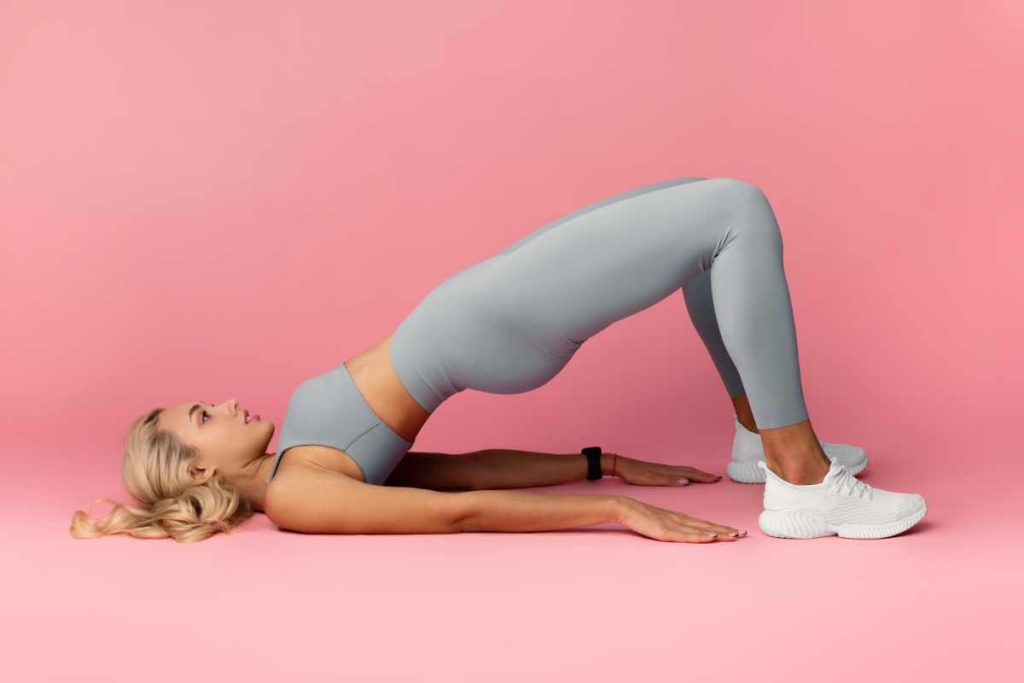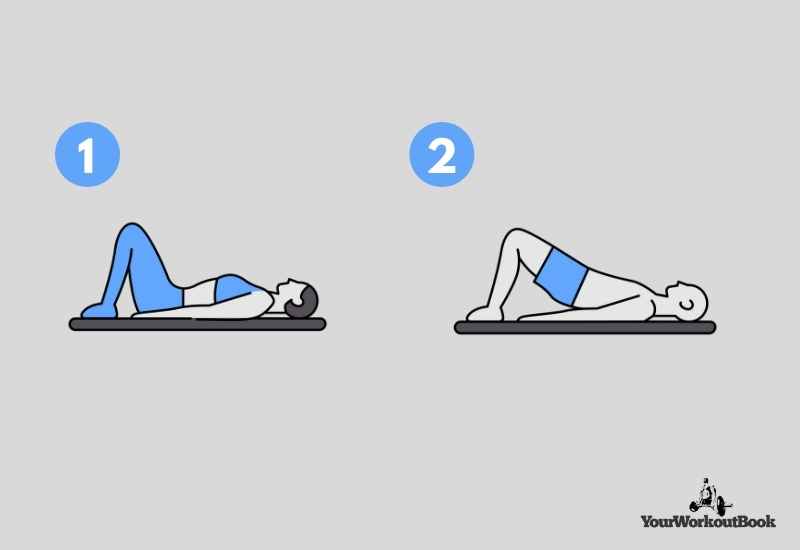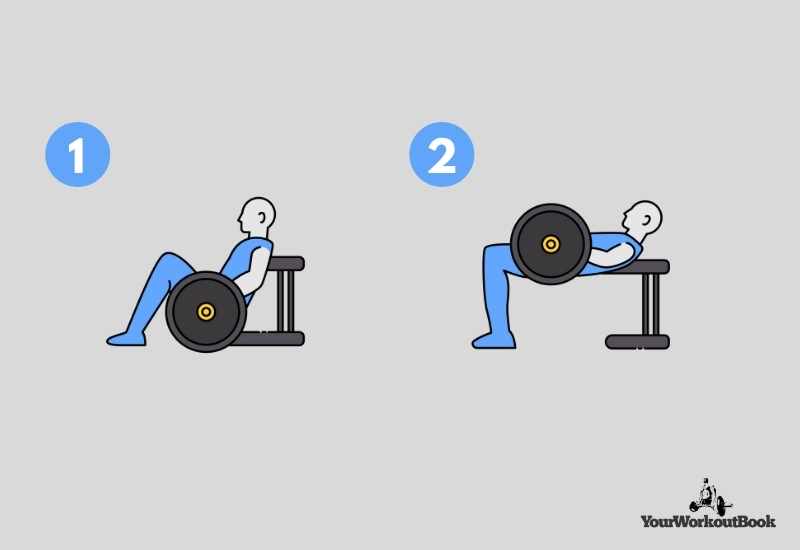While they look very similar, the hip thrust and the glute bridge are very different exercises targeting different muscles. Here’s a deeper look at the differences between these popular glute-building exercises.

Your hips and glutes are crucial muscles for a fit, mobile body!
These two core muscles—along with your back, abs, and obliques—connect your upper and lower body, allowing you to bend, twist, run, flex, swing your arms, kick your legs, and pretty much every other form of movement.
Unfortunately, they also get far less attention than the more “important” or “flashy” muscles.
You know it’s true: we all want a six-pack, so we spend lots of time training our abs. Or maybe we’re worried about back issues, so our lower backs get plenty of love.
But your hips and glutes are just as important! It’s vital that you spend time training these muscles in order to maintain good mobility and strengthen the lower portion of your core.
To that end, there are two highly effective exercises to choose from: hip thrusts and glute bridges.
These two exercises are fairly similar—as you’ll see below—but there are just enough differences between them that you should consider both of them as a good addition to your workout.
We’ll walk you through the pros and cons of each and help you understand which is the best choice for which purpose.
(And no, don’t worry that all the time you spent shopping for the best hip thrust pad will be wasted. A hip thrust pad can be just as useful for glute bridges!)
Let’s jump right in.
The Glute Bridge – Overview
The glute bridge is a floor-based exercise that can be performed with or without weights (typically without).
To do the glute bridge:
- Lie on your back on a Yoga mat or directly on the floor, with your knees bent and your feet planted flat on the ground.
- Squeeze your glutes and thrust your hips up toward the ceiling.
- Thrust until your hips are as high in the air as you can manage (without feeling tension in your lower back), pause for a 1-count, then lower slowly back to the floor.
- Repeat as desired.

Glute bridges engage your glutes, hip flexors, obliques, abdominals, lower back, and hamstrings.
The Hip Thrust – Overview
The hip thrust is pretty much the same as a glute bridge, only instead of working on the floor, you place your back on a bench. It’s also the exercise more likely to be loaded (using a barbell placed across your lap).
If you want to know how to do a hip thrust, it’s really very easy:
- Sit with your upper back and shoulders resting against a flat bench, and a barbell cradled in your lap. Bend your knees and place your feet flat on the floor out in front of you.
- Press your upper back and shoulders into the bench and your feet into the floor, and thrust your hips up toward the ceiling.
- Thrust upward until you reach a tabletop position (flat spine), pause for a 1-count, then lower under control.
- Stop at a natural “low point”—typically, your butt will be a few inches off the ground—hold for a 1-count, then thrust again.
- Repeat as desired

Hip thrusts engage your glutes, hip flexors, obliques, abdominals, lower back, and hamstrings—all the same muscles worked by glute bridges.
See also: What Muscles Does the Barbell Hip Thrust Work?
Using a hip thrust pad allows you to comfortably support weight on your hips, making the thrust-and-lower action more difficult and thereby working all your core muscles more effectively.
The benefits of hip thrust are mostly the same as the benefits of the glute bridge, but, as you’ll see in the next section, there are a few minor differences that separate the two movements.
The Main Differences Between the Hip Thrust and Glute Bridge
Difference #1: Load
Of the two, it’s more likely that you’ll load up weight on a hip thrust. This is due to the positioning of your body.
With a glute bridge, your upper back and shoulders are on the floor, which means there is a sharp angle of decline from your knees to your chest.
Trying to keep a weight secure on your hips will take a lot more effort, and there’s a higher chance that the barbell will roll up to your abs or chest. This not only increases injury risk, but also shifts the focus of the exercise away from your glutes and hips.
With a hip thrust, however, your body forms a flat tabletop position, so there’s nowhere for the weight to slide or shift. At the “low point” of the hip thrust, the barbell is cradled in your lap (on a hip thrust pad), so it will remain firmly in place.
Typically, glute bridges are performed with just your bodyweight—a variation you can do at home, at the office, even while on vacation.
No equipment is needed at all (not even a Yoga mat if you don’t have one), just your body and the floor!
Difference #2: Muscle Focus
Both hip thrusts and glute bridges target your glutes and hips, with some engagement of the hamstrings, abs, and lower back. However, because of your posture, the focus shifts slightly with each exercise.
The downward-sloping angle of the glute bridge targets higher up on your spinal column, so your lower back gets marginally more engagement along with your glutes and hips. With hip thrusts, there is fractionally less low back engagement, with the main focus on your glutes and hips.
However, the difference between the two exercises is VERY minor. The fact that you’re training your glutes, hips, and lower back is one of the best glute bridge and hip thrust benefits, and one of the reasons both exercises are so popular.
Difference #3: Comfort
Glute bridges are significantly more comfortable than hip thrusts for the simple reason that there is no added weight. You’re typically using just your bodyweight throughout.
Note: You can use a hip thrust pad to load up a barbell on your lap for glute bridges, but it won’t be very comfortable and you’ll struggle to keep the weight securely in place.
With hip thrusts, you’ve got a heavy barbell cradled in your lap, and you’ll feel the pressure directly on your hips and groin area. Without a pad to cushion the barbell, hip thrusts are a VERY uncomfortable exercise.
Difference #4: Difficulty Level
Working with your bodyweight helps to develop functional fitness, but it’s also typically easier than lifting heavy weights. Glute bridges are excellent for beginners because there is no weight involved, very little that can go wrong with your form, and thus it’s just a much easier exercise overall.
Hip thrusts, however, take a bit more effort to master. You’ve got to struggle to get the weight in place, keep it secure on your hips, AND focus on the form throughout the full range of motion. Too much weight can throw off your form, and too little weight will reduce the effectiveness of the exercise.
See also: 5 Best Hip Thrust Machines for Monster Glutes
With hip thrusts, the learning curve is steeper, making it a more difficult exercise by a decent margin.
Hip thrusts also require a greater range of motion than glute bridges. If your hip hinge is tight or your mobility is reduced (due to injury or sedentary lifestyle), you may want to focus on glute bridges initially and work your way up to the more demanding hip thrusts.
Difference #5: Injury Risk
When you’re dealing with bodyweight vs. external load, there is also a higher risk of injury with the latter.
Glute bridges are a much safer choice because there is no load, so you can move your bodyweight naturally and comfortably until you feel the tension and fatigue in your muscles telling you it’s time to take a break.
With hip thrusts, there is an external load that is making the exercise more difficult, so if you don’t follow the proper form through the full range of motion, you run the risk of injuries.
Injury risk is also higher if you overload the barbell and try to lift more weight than your body can handle.
Hip Thrust vs Glute Bridge – FAQs
Is the hip thrust or glute bridge better for building stronger glutes?
If your goal is to build strength, hip thrusts are the better choice simply because of the addition of the barbell. Working with an added load will always lead to increased muscle growth.
You’ll be able to increase the weight and force your body to adapt to the higher demands, which prompts it to build new and expand existing muscle fibers to store more energy. This translates into greater overall strength!
Should I do both exercises on the same day?
Absolutely! Treat the glute bridge like a warm-up to get your muscles woken up and ready to work, as well as to limber up your hips and lower back. It’s the perfect movement to start training your hip hinge.
Then, once you’ve done a few sets of bodyweight glute bridges, you can move on to hip thrusts confident that your hips, glutes, and lower back are ready to handle the strain!
The Bottom Line
Both hip thrusts and glute bridges are excellent exercises to target your glutes, hips, and lower back, developing the core muscles needed to move more easily. Each has their benefits, however, so should be included in your workout accordingly.
Glute bridges are the easier, safer, more accessible option that will help you warm up and wake up your hip hinge muscles. It’s also an exercise you can perform anywhere with no equipment needed.
Hip thrusts, however, are the choice if you want to “level up”—they’ll help you build serious strength and increase your range of motion.
Whether you lift heavy or start off easy, what matters MOST is that you pay attention to these critical core muscles!
More Hip Thrust Guides:
? 8 Best Barbell Hip Thrust Pads for Monster Glutes. Hip thrust pads are a quick way to protect your hips, stabilize the bar, and push more weight. Here is a breakdown of my favorite barbell pads for hip thrusts.
How to Master the Hip Thrust (Technique, Reps, and More). Here’s everything you need to know about performing the hip thrust—the best exercise you can do for strong and muscular glutes.